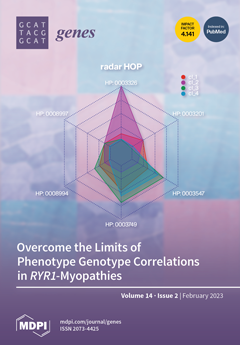Inducible nitric oxide (NO) synthase (iNOS), encoded by the
NOS2 gene, promotes the generation of high levels of NO to combat harmful environmental influences in a wide range of cells. iNOS can cause adverse effects, such as falling blood pressure, if overexpressed. Thus,
[...] Read more.
Inducible nitric oxide (NO) synthase (iNOS), encoded by the
NOS2 gene, promotes the generation of high levels of NO to combat harmful environmental influences in a wide range of cells. iNOS can cause adverse effects, such as falling blood pressure, if overexpressed. Thus, according to some data, this enzyme is an important precursor of arterial hypertension (AH) and tension-type headache (TTH), which are the most common multifactorial diseases in adults. The purpose of this study was to investigate the association of rs2779249 (chr17:26128581 C>A) and rs2297518 (chr17: chr17:27769571 G>A) of the
NOS2 gene with TTH and AH overlap syndrome (OS) in Caucasians in Eastern Siberia. The sample size was 91 participants: the first group—30 patients with OS; the second group—30 patients AH; and the third group—31 healthy volunteers. RT-PCR was used for the determination of alleles and genotypes of the SNPs rs2779249 and rs2297518 of the
NOS2 gene in all groups of participants. We showed that the frequency of allele A was significantly higher among patients with AH compared with healthy volunteers (
p-value < 0.05). The frequency of the heterozygous genotype CA of rs2779249 was higher in the first group vs. the control (
p-value = 0.03), and in the second group vs. the control (
p-value = 0.045). The frequency of the heterozygous genotype GA of rs2297518 was higher in the first group vs. the control (
p-value = 0.035), and in the second group vs. the control (
p-value = 0.001). The allele A of rs2779249 was associated with OS (OR = 3.17 [95% CI: 1.31–7.67],
p-value = 0.009) and AH (OR = 2.94 [95% CI: 1.21–7.15],
p-value = 0.015) risks compared with the control. The minor allele A of rs2297518 was associated with OS (OR = 4.0 [95% CI: 0.96–16.61],
p-value = 0.035) and AH (OR = 8.17 [95% CI: 2.03–32.79],
p-value = 0.001) risks compared with the control. Therefore, our pilot study demonstrated that the SNPs rs2779249 and rs229718 of the
NOS2 gene could be promising genetic biomarkers for this OS risk in Caucasians from Eastern Siberia.
Full article






